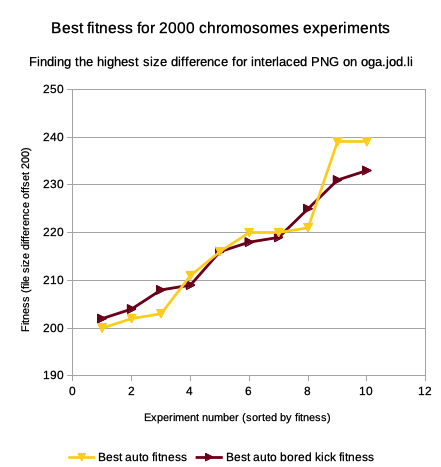What is the bored kick?
It can happen that the best fitness for several batches remains within narrow boundaries without improvement forming thus a plateau. The auto evolution of genetic algorithm parameters can take time to find the appropriate parameters to overcome this plateau.
The bored kick parameter is the number of batches to evaluate for a population to be considered boring and deserving a kick. The kick is given to some parameters provided they are set to be auto optimised. This generally consists in increasing the randomness of the population.
Increase of parameters:
- mutation
- mutation proportion
- chunk addition
- chunk deletion
- chunk swap
Decrease of parameters:
- elitism
- niche distance ratio (depends on the spread of the population)
This applies only if the latest batch does not contain the highest fitness chromosome.
Experiments
The PNG interlace experiments have been run to understand the impact of a bored kick of 10 on the results.
The general outcome regarding the bored kick parameter through experiment results is that it leads to best fitnesses more concentrated as shown below:


Indeed, the best fitnesses curve tend to flatten with the bored kick set to 10 batches.
Conclusion
The bored kick mechanism can be used to increase the probability for a genetic algorithm to reach a reasonable best fitness but it does not necessarily lead to generally improved results. The probability for worst performance is lower as well as the probability for best performance.
Future work
- Make more experiments with different values of bored kick.
- Make experiments trying to solve different problems than the PNG interlace question.
